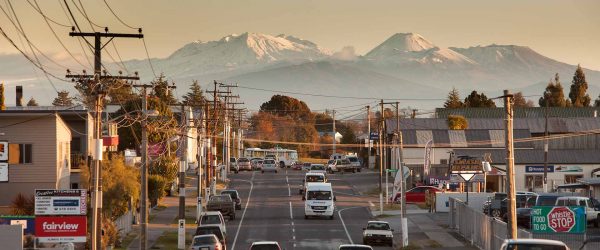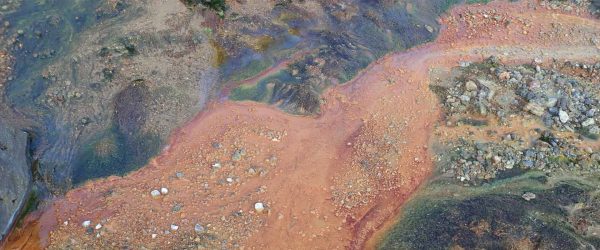Volcanic Impact Models - The ‘eVolcano Testing Lab’
Ngā tauira pāpātanga puia – te ‘Taiwhanga Whakamātau eVolcano’
Vision
Decisions about safe and sustainable development and emergency management planning in Aotearoa New Zealand are supported by reliable and detailed forecasts of the hazards and impacts of volcanic eruptions.
Project description
Decisions about development, infrastructure investment and emergency planning in our volcanic areas should ideally be based on reliable forecasts of volcanic hazards and the likely impacts on communities, infrastructure and the economy. Historically, the technology and detailed insights required for such forecasts have not been available.
In tandem with the Multi-hazard Forecasting project, we are developing reliable forecasts of complex and variable volcanic hazards and impacts. When eruptions occur, our work will also provide detailed information about likely hazards and impacts to inform emergency response decisions.
To achieve this, we are developing new computational simulation tools to forecast specific hazard processes such as lava flows, ash dispersal, ballistics, and gas before and during eruptions. We are also systematically studying and testing the impacts of these hazards on infrastructure and the environment. Specifically, we are:
- Developing a new-generation volcanic impact analysis by testing the physical and chemical impacts of a range of volcanic activity.
- Trialling new methods for collecting and visualising hazard impact data.
- Mapping volcanic hazards with their impacts on infrastructure and the environment.
- Developing a suite of new computational modelling tools for improving the assessment of volcanic hazards and likely impacts.
By providing decision-makers and emergency management planners with reliable forecasts of volcanic hazards and impacts, our goal is for Aotearoa New Zealand’s economy, infrastructure and society to be more resilient to volcanic activity.
Wawata
E tautokohia ana ngā whakataunga mō te whakawhanake haumaru, toitū hoki, me te whakamahere whakahaere ohotata i Aotearoa e ngā matapae horopū, āmiki hoki mō ngā mōrearea me ngā pāpātanga puia.
Whakaahuatanga papatono
Me aro ngā whakataunga mō te whakawhanaketanga, te haumitanga tūāhanga me te whakamahere ohotata i ngā rohe puia ki ngā matapae horopū mō ngā mōrearea puia me ngā pāpātanga ka pā pea ki ngā hapori, ki te tūāhanga me te ōhanga. I mua, kāore he hangarau, kāore he tirohanga āmiki mō aua momo matapae.
I te taha i te Kaupapa Te Matapae i ngā Tini-mōrearea, e whakawhanake ana mātou i ngā matapae horopū mō ngā mōrearea puia me ngā pāpātanga taurangi, tuatini hoki. Ina puta tētahi hūnga, ko tā mātou mahi he tuku i ngā mōhiohio āmiki mō ngā mōrearea me ngā pāpātanga ka puta pea hei ārahi i ngā whakataunga urupare ohotata.
Hei whakatutuki i tēnei, kei te whakawhanake mātou i ngā rauemi whaihanga ā-rorohiko hei matapae i ētahi tukanga mōrearea pērā i ngā tere tahepuia, te hora o te pungarehu, te āhua o te whiu o ngā toka puia, me te haurehu i mua, i te wā hoki o te hūnga. E rangahau, e whakamātau nahanaha ana hoki mātou i ngā pāpātanga o ēnei mōrearea ki te tūāhanga me te taiao. Inarā, kei te:
- Whakawhanake i tētahi tātaritanga pāpātanga puia putanga-hou mā te whakamātau i ngā pāpātanga ōkiko, matū hoki o ētahi momo ahi tipua rerekē.
- Whakamātau i ngā tikanga hou mō te kohi me te whakaatu i ngā raraunga pāpātanga mōrearea.
- Whakamahere i ngā mōrearea puia me ngā pāpātanga ki te tūāhanga me te taiao.
- Whakawhanake i tētahi huinga rauemi whakatauira ā-rorohiko hou hei whakapai ake i te arotake o ngā mōrearea puia me ngā pāpātanga e tinga ana.
Mā te tuku i ngā matapae horopū mō ngā mōrearea me ngā pāpātanga o ngā puia ki ngā kaiwhakamahere whakahaere ohotata, ko tō mātou whāinga kia manawaroa ake te ōhanga, te tūāhanga me te pāpori o Aotearoa ki ngā ahi tipua.
Resource Outputs from this project
Tephra fall impacts to buildings: the 2017-2018 Manaro Voui eruption, Vanuatu
These results contribute to the limited empirical data available for tephra fall building damage and can be used to calibrate existing fragility functions, improving our evidence base for forecasting future impacts for similar construction types globally.
Turbulent particle-gas feedback exacerbates the hazard impacts of pyroclastic density currents
Direct measurements of destruction-causing dynamic pressure in large-scale experiments.
Time varying crustal anisotropy at Whakaari/White Island volcano
This study investigates variations in anisotropy at Whakaari/White Island between 2018 and 2020, during quiescence, unrest, and the 2019 eruption.
Modeling SO2 dispersion from future eruptions in the Auckland Volcanic Field, New Zealand
S. Brody-Heine, M. Katurji, C. Stewart, T.Wilson, E.R. Smid, R.Trancoso, 2024. Modeling SO2 dispersion from future eruptions in the Auckland Volcanic Field, New Zealand Journal of…
Porosity, strength, and alteration – Towards a new volcano stability assessment tool using VNIR-SWIR reflectance spectroscopy
Testing the accuracy of spectroscopy--a remote, non-destructive assessment tool--on determining rock strength, porosity and mineral alteration.
Rock alteration mapping in and around fossil shallow intrusions at Mt. Ruapehu New Zealand with laboratory and aerial hyperspectral imaging
Rock alteration influences volcano stability and related hazards. Can hyperspectral data be used to accurately quantify alteration around volcanoes?
Characteristics and controls of the runout behaviour of non-Boussinesq particle-laden gravity currents – A large-scale experimental investigation of dilute pyroclastic density currents
Large-scale experiments using hot volcanic material provide insights into pyroclastic flow behaviour that can inform hazard mitigation.
Pyroclastic flow experiments to improve volcanic hazard models
Large-scale experiments are providing new insights one of the most dangerous volcanic hazards so we can better predict their impacts and behaviour.
Remote Characterization of the 12 January 2020 Eruption of Taal Volcano, Philippines, Using Seismo-Acoustic, Volcanic Lightning, and Satellite Observations
A postevent analysis of the 12 January 2020 eruption of Taal Volcano in the Philippines, using remote sensing methods.
Probabilistic volcanic hazard assessment for national park infrastructure proximal to Taranaki Volcano
Mead, S.R., Procter, J.N., Bebbington, M. & Rodriguez-Gomez, C. (2022) Probabilistic volcanic hazard assessment for national park infrastructure proximal to Taranaki Volcano. Frontiers in Earth…
Quantifying location error to define uncertainty in volcanic mass flow hazard simulations
Mead, S.R., Procter, J. & Kereszturi, G. (2021) Quantifying location error to define uncertainty in volcanic mass flow hazard simulations. Natural Hazards and Earth Systems…
Destructiveness of pyroclastic surges controlled by turbulent fluctuations
Brosch, E., Lube, G., Cerminara, M. et al. (2021) Destructiveness of pyroclastic surges controlled by turbulent fluctuations. Nature Communications 12, 7306. https://doi.org/10.1038/s41467-021-27517-9
Probabilistic volcanic mass flow hazard assessment using statistical surrogates of deterministic simulations
Mead, S.R., Procter, J.N. & Bebbington, M. 2022. Probabilistic volcanic mass flow hazard assessment using statistical surrogates of deterministic simulations. Earth and Space Science Open…
Agriculture and forestry impact assessment for tephra fall hazard: Fragility function development and New Zealand scenario application
Fragility functions are then used to demonstrate a deterministic impact assessment with current New Zealand exposure.
Volcanic ballistic projectile deposition from a continuously erupting volcano: Yasur Volcano, Vanuatu
Fitzgerald RH, Kennedy BM, Gomez C, Wilson TM, Simons B, Leonard GS, Matoza RS, Jolly AD, Garaebiti E. 2020. Volcanic ballistic projectile deposition from a…
Quantifying asset and visitor risk at Mt. Taranaki, New Zealand from multiple volcanic hazards.
Procter J, Mead S, Bebbington M. 2020. Quantifying asset and visitor risk at Mt. Taranaki, New Zealand from multiple volcanic hazards [abstract]. In. European Geosciences…

